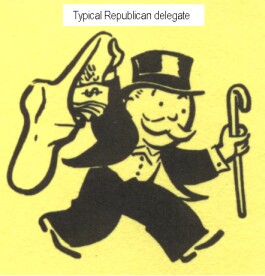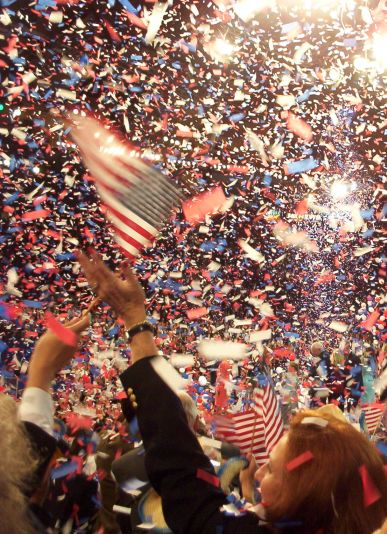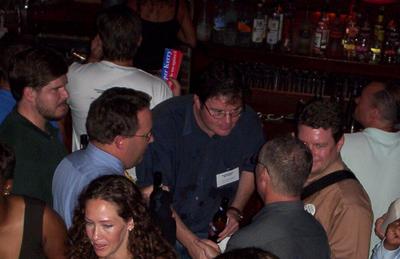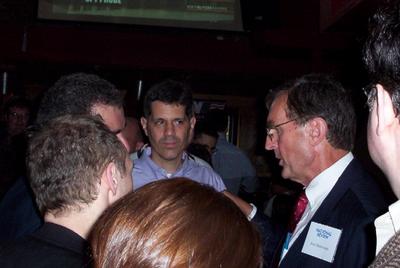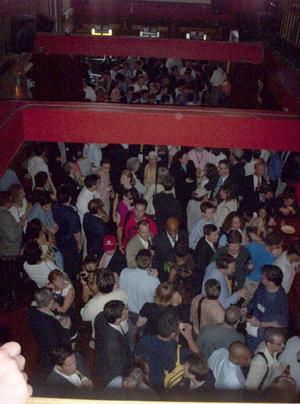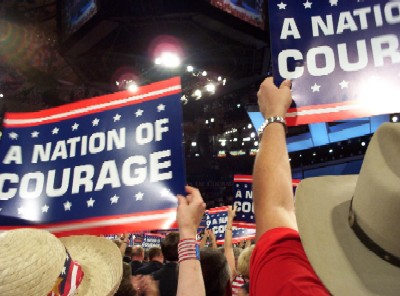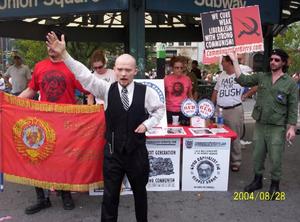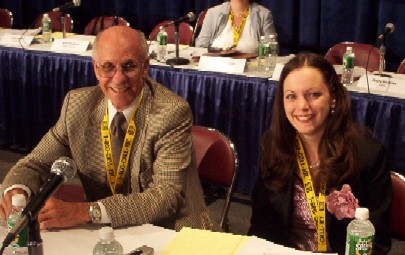"The Republicans came to town with the Ten Commandments in one hand and a $100 bill in the other, and they didn't break either." -- New York State Senator John Sabini, Democrat from Queens, in the September 4, 2004, New York Post.
Local politicians love to be able to tell voters that they've created jobs, and for forty years or more, the pursuit of convention business has been a favorite way to spend city dollars in hopes of drawing tax dollars to the city from visitors -- people who come, stay, spend, and leave before they become a burden on the city's infrastructure. Despite plenty of evidence that cities rarely make back in increased tax revenues what they spend on the operating cost of convention centers, not to mention the initial capital cost of building or expanding a convention center, or the extra financial incentives offered to major conventions, local politicians still push for higher taxes to finance ever bigger and fancier convention facilities, adding to a glut of underutilized facilities.
I've followed the antics of convention center promoters for many years. In 2000 I led a successful opposition campaign against a convention center expansion and new arena for downtown Tulsa. The project was to be funded by a city sales tax increase and it was sold as a way of generating new convention business for Tulsa, filling empty hotel rooms, and preventing us from becoming a "fourth-tier" city in the competition for national conventions and trade shows. If we voted for the expansion, we were told to expect $100 million in additional direct spending annually -- a threefold increase over the actual direct spending numbers at the time. In debunking their numbers and making our case, we depended heavily on the research done by Heywood Sanders, a professor at the University of Texas at San Antonio, and the nation's leading expert on convention center economics, who has made a career of comparing the claims of feasibility studies to the results produced by new and expanded convention centers.
Tulsa's arena and convention center package was ultimately sold to the voters in 2003 as part of a billion-dollar package of corporate welfare ($350 million to Boeing for an aircraft assembly plant), parks, university facilities, street improvements, and assorted other pieces of pork, collectively known as Vision 2025, and funded by a 1% sales tax. In the 2003 vote, promoters talked as little as possible about the convention center and arena, and instead pointed to the city's dire economic circumstances -- second only to San Jose in job losses in the wake of the tech bubble's bursting -- and convinced the voters that "we have to do something," never bothering to provide an economic rationale for their claims that Vision 2025 would pull us out of the doldrums. When they did respond to projections that the convention center would run an even bigger operating deficit after expansion, the convention center promoters would claim that increased sales tax revenue generated by additional visitor spending would more than make up for the deficit.
For all that I've read about convention center economics, I don't often go to conventions, so it's been interesting to have an inside look, as a delegate, at a "pearl of great price" in the convention industry -- the kind of event that cities would give everything to attract. And they often have.
New York City has been a great host, and I would love to come back to New York for the 2008 Republican convention, but I wouldn't blame New Yorkers for rolling up the welcome mat. Mind you, not because of political differences, but because an event of this magnitude may cost far more than any economic benefit.
Early estimates from New York City's Economic Development Corporation (EDC) put the net economic impact of last week's Republican National Convention at $255 million, but the numbers are based on economic models and standard industry figures for delegate spending, not actual receipts, using $220 per person per day for five days as a spending estimate for the 47,000 visitors. And that $255 million is a net number -- $341 million in spending, less $86 million in lost retail activity.
It's hard to tell how close those numbers are to reality. Our room was $155 a night, and I'd estimate that my wife and I spent another $50 a day on food and taxi or subway fare, plus incidentals. Four young women in our delegation shared a single hotel room to save money. A lot of additional money was spent on us by various corporations and politicians at the breakfasts and receptions we attended, but I suspect that would still leave the total well shy of the number used by the EDC. Last month, New York City's comptroller estimated that the city would lose $309 million on the convention, the result of all the disruptions and inconveniences connected with the event.
Looked at through the eyes of a convention planner, a national political convention is an odd combination of a trade show and a SMERF event. SMERF stands for social, military, educational, religious, and fraternal organizations. These are the least coveted conventions, because delegates are attending on their own behalf and are spending their own money, not traveling on expense accounts, and accordingly they stay at budget accommodations (or double up in luxury accommodations) and look for restaurant bargains. Like delegates at most SMERF events, RNC delegates paid their own way to New York, as did thousands of volunteers. But then there were also thousands of media staff, campaign staff, and Republican party staff who were at the convention for business reasons and so were traveling on someone else's dime. Economic impact calculations had better take the dual nature of these conventions into account.
The New York papers have had fun recounting delegate penny pinching. A New York Post article featured complaints from hotel concierges who were getting "God bless yous" instead of gratuities in thanks for their assistance. One indignant concierge blasted the thrifty delegates: "They even ask where the nearest Laundromat is so they can wash their own clothes. Look, if you can't afford to travel, don't come." We didn't go to the laundromat or let the hotel do our laundry -- it would have been cheaper to buy replacements. As a way to save money on drinks, we brought along an insulated, leakproof piece of luggage which can be used as a cooler. We bought 6-packs of Diet Cokes for $2.99 each from a nearby drugstore, and filled the cooler with just enough ice from the hotel's machine to keep the sodas cold.
Merchants and restaurateurs near Madison Square Garden suffered badly during the convention, as did Broadway. I wonder, too, about the impact of a nearly empty Javits Center. The Republican committee meetings the week before the convention used only a tiny fraction of the Javits Center, but the rest of the cavernous center was left empty, presumably for security reasons.
New York City taxpayers bore a large chunk of the security costs of this convention -- as much as $15 million out of an expected total cost of $65 million. (The rest of the money comes from the Federal Government.)
Unlike most cities that chase convention business, New York City can plausibly claim that even losing money on this convention, particularly one that draws from every state in the union, can help the city in the long run. Thousands of delegates who had never been to the city, or hadn't been since the bad old days, pre-Giuliani, came away with very positive impressions of the city and are more likely to return and to excite their friends and relatives about visiting. Someone attending a convention in Wichita, let's say, might feel that he had exhausted the tourism potential of the city in the course of a week-long meeting. Nice city, but no plans to return. Most Republican delegates in New York left with a sense of unfinished business, unable to exhaust the possibilities that New York City offers in the handful of free hours we had each day. We will be back.
Beyond the economic impact, the presence of tens of thousands of Republicans had a positive impact on the small but mighty band of local conservatives. Blogger and political consultant Karol Sheinin wrote, "I love the convention being in my city. All the regular rightwing events are on steroids, with more people than ever and a great vibe." Beyond regular events, like the New Criterion's Tuesday evening gatherings at Fitzgeralds, special events connected with the convention, like the National Review cocktail hour cum mosh pit at Turtle Bay, "The Right Stuff" comedy show, and the Club for Growth's events, gave local conservatives a chance to find each other, as they emerge from the catacombs.
Who knows but that a few more such boosts may help develop a thriving conservative social scene in New York City? Shouldn't the capital city of capitalism be the capital of conservatism, too? Conservatives from the rest of the country should offer, out of the goodness of our hearts, to gather annually in Manhattan for a major political shindig -- not so major that it shuts down whole neighborhoods, but major enough to draw the biggest names and the brightest rising stars, a week-long celebration of conservatism. Just like a national convention, but minus the convention sessions, which just get in the way of all the parties and receptions. Yes, we could have it on some cruise ship in the Caribbean, but it would encourage our New York brethren more to have it in their midst. I'm willing to sacrifice for the cause. How about you?
